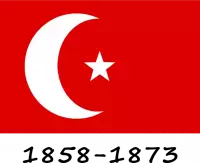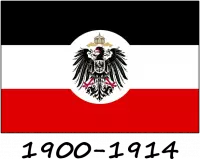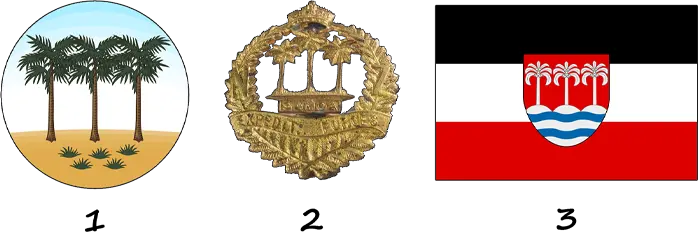In the mid-19th century, Samoa attracted the attention of European powers seeking to expand their influence in the Pacific region. The flag used in Samoa during this period was a red field with a white crescent and a star, reminiscent of the Ottoman flag of the same time, although there is no direct evidence of the Ottoman Empire's influence on Samoa, and it had no official status.

In 1873, Germany, Great Britain, and the United States began to actively expand their influence in Samoa, concluding trade agreements with local chiefs and opening their own trading posts. In addition to the flags of the European powers, Samoa also had local flags used by various chiefs promoting affiliation with a particular colonial power.
Since 1875, a red flag with a white cross and a white star in the canton has been used. It was recognized by people who supported Malietoa Laupepa as the paramount chief of Tuamasaga (an administrative district of Samoa located in the central part of the island of Upolu).

Malietoa Laupepa was proclaimed king of Samoa in 1868 under the influence of the British consul and was first crowned in 1875. However, this was not accepted by the Tumua Atua and Aana factions (although they had previously supported him), and they subsequently formed their own government led by Tupua Tamasese. In 1887, the German military forced Malietoa Laupepa and other chiefs to sign a document proclaiming Tui A'ana Tupua Tamasese Titimaea as the king of Samoa. Tupua Tamase's flag was a white field with a black cross over Laupepa's white cross and a white five-pointed star in a red canton, making the German colors even more prominent. In 1888, a civil war broke out against Tamase and his German allies, leading to the signing of the Berlin General Act of June 14, 1889, by Germany, Great Britain, and the United States, which proclaimed Laupepa king again and brought his red and white flag back into use.

In 1900, after the division of Samoa between the colonial powers, Western Samoa came under the control of the German Empire. For this period, a standard flag for German colonial possessions was used - the flag of the German Empire, called the “Reichsadler”. This flag consists of three horizontal stripes: black, white, and red, as a symbol of German unity, with a black eagle emblem in the center. The eagle represents imperial grandeur and sovereignty, and the crown on its head emphasizes Germany's status as a powerful monarchy. The imperial eagle was used on the territory of Samoa until 1914, when it was occupied by New Zealand troops.

New Zealand invaded Samoa at the beginning of World War I, namely on August 29, 1914. Until 1920, the current flag of New Zealand was used - a blue cloth with the Union Jack in the canton and 4 red stars of the Southern Cross surrounded by a white outline. On June 28, 1919, the Treaty of Versailles was signed, according to which the former German territories of Samoa came under the mandate of the League of Nations, and New Zealand officially gained control of us on December 17, 1920, although it had actually ruled us since 1914. At the same time, the official blue flag with the image of three palm trees in the sand was introduced.

The three coconut palms (1) may indicate the presence of the New Zealand Expeditionary Force (NZEF) in Samoa during World War I (1914-1918). The cockade (2) of the NZEF hat featured three palm trees, a crown, and a fern branch. The palm trees were borrowed from a previously proposed flag of German Samoa (3), which was not adopted.

After the Second World War, Western Samoa became a trust territory of the United Nations and later came under the jurisdiction of New Zealand. In 1948, Samoa adopted its own red flag with four white stars of the Southern Cross constellation in a canton on a blue background, and later a fifth star was added to the constellation. Western Samoa became independent on January 1, 1962, later renamed the Independent State of Samoa.










